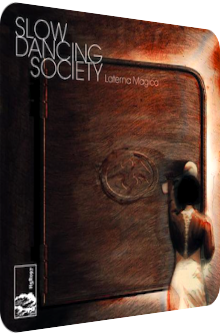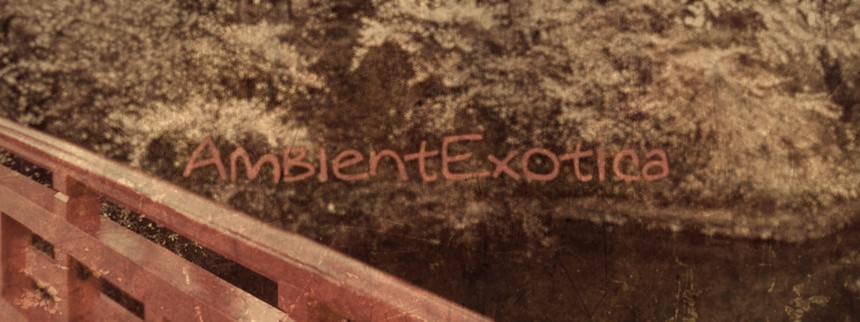
Slow Dancing Society
Laterna Magica
2012
Laterna Magica is the fifth album by the Spokane, Washington-based guitarist and synth expert Drew Sullivan aka Slow Dancing Society, released in September 2012 on Hidden Shoal Recordings and comprising ten polyvalent Ambient compositions. It can be fully streamed and purchased at Bandcamp. Ennobled by guitars, glockenspiels and a piano, the dense synth cavalcades of Laterna Magica are miraculous entities whose true complexion not only depends on the interpretation of the listener, but the amount of light that is aurally emanated from the titular lantern which is actually a nod to the eponymous image projector of the 17th century. Light is usually seen as positive and, well, enlightening, but Sullivan’s album is his most ophidian and eclectic one to date, even though the camouflaging fogginess and thermal silkiness might suggest otherwise. From the outset, it is a welcome choice that Sullivan revisits the concept of light after such a comparably short time frame, for his album Under The Sodium Lights (2010) sported a similar viewpoint. On Laterna Magica, however, the light of this aural lantern is a diffuse one, a transfiguring incandescence whose effulgence excludes clefts, bumps and interstices of the objects it illumines or projects onto the wall. The adjacent retro synths and dark matter pads do neither depend on this source of light, nor are they influenced by it, and so a dichotomous interplay builds up which is as enchanting as it is exciting and, as it turns out in the end, incomprehensible, a bewildering state which I try to carve out in greater detail below. How enmeshed are light and darkness, in which ways does Slow Dancing Society inject the magnanimous amounts of rapture and joy that traverse each of his works, and how does one cope with the New Age-colored mysticism of that magic artifact? Almost a year after the initial release, I am willed to jot down my observations. Since Laterna Magica is a concept album, these questions are important, and answering them is as momentous as it is prone to failure. Since this is only the beginning of my review, the impetus of that very failure can only grow. Let’s hope the light of Laterna Magica lessens this notion.
After The Twilight Takes Us opens the album in a dubious way, at least when one considers its title: does it carry relief or portent? It is consoling that the journey is not taken alone. The slow and soft fade-in phase may be dreamy and comprising of gunmetal fog banks, but cannot annihilate all cloudy thoughts. These gaseous ameliorations seem to be the glowing light sources of the track and waft around pristine piano prongs, screeching synth strings and abyssal bass aortas, the latter of which slide into shadier tone sequences which unchain darker contraventions. However, as the twilight state progresses, the gelid mélange of aeriform drones offers anything but contentment and contemplation. Follow-up Bones & Ice (Summer Trees Turn) remains hued in twilight, Sullivan’s Priest Lake Circa ’88 (2008) is surprisingly far away despite the titular allusions of loftiness and verdure. This composition, however, is loaded with ashen synth aortas, glistening glockenspiels, coruscating chimes and the occasional appearance of bucolic bonfire guitars. There is warmth all over this piece, but it has to shimmer through a dense legato thicket of the archetypical New Age timbre, an impression which is especially applicable in the first half with its moist-wooden clicks, star dust glitters and twirling gusts.
During the following A Few Moments, Slow Dancing Society even amplifies the nod to the Age of Aquarius by placing aqueous vesicles in-between crystalline specters, four-note guitar scents and piano sparks. The synth washes in the background and the reverberations of the bubbling bits work in tandem and create an antrum whose wideness and plasticity lead back to the album title: it is lit with magic and functions as a peaceful sanctuary whose mood is hard to pinpoint. Gardens & Graves could have potentially been a similarly dualistic track, were it not for the vigorous and prominently placed guitar-and-piano protrusions which reign in front of a cosmic square lead flute and hammering synthetic bassline. But even when these devices are mute, the grey airflows feel organic and joyful. The track title makes the comparison to Chihei Hatakeyama’s Ghostly Garden (2010) an all too easy one, but it is true, Sullivan’s haze is similarly structured and, most importantly, alluvial. Next is the most progressive polyhedron piece of tonal cinematography: I’ll Leave A Light On. It appears in a shapeshifting gestalt; from forsaken piano chords and bass-accentuated rufescent lute helixes over a 4/4 bassline-underpinned ophidian dark matter travelog to a true-bred Space Ambient conclusion with glistening polar light particles and nectarian nebulae, I’ll Leave A Light On is a murky, constantly pressing piece and a melodramatic counterpoint to the album’s endemic ambience.
After the daemoniac glow, I’ll See You In Time returns to the vitreous-diffuse panorama Drew Sullivan is known for. After a semi-glitchy anacrusis of sparkling screeches and incisive scintillae, a purified guitar aorta is embedded in majestic synth strings which oscillate between a camouflaged diffusion and a glazed translucence. Eminently opalescent and even euphoric, this is a piece that bathes, drowns and then submerges into sumptuous solemnity. While Pieces Of Your Presence is a comparably short interlude supercharged with rotor-esque bit-crushed staccato flecks, liquedous synth afterglows, gorgeous six-note cascades and lacunar cusps, A Slow Parade Of Wind returns to a warm mirage of rural fluxions, runlets of synth strings as well as guitar twangs, twinkling glockenspiels and high piano tones. The wind which is evoked in the title is nowhere to be heard, its omission hence transforms A Slow Parade Of Wind into a beautifully beatific piece. The lantern truly shines – or projects – all the more in there, but continues to fathom out contrastive turbulences in the penultimate There’s A Place For Us which kicks off with emaciated shakers and clicks in front of a pitch-black pith of nonentity. This darkness is soon enough lit by galactic gongs and pulsating bleeps. Once the wadded synth underbrushes continue to grow, so does the New Age factor. The track remains highly interesting though, for it is the only piece where Slow Dancing Society truly worships the darker backgrounds, the interplanetary interstices and echoey vestibules. The consolatory Tomorrow’s Another Day is the Glitch-bred Ambient apotheosis to Laterna Magica and once more stresses the unlit, gloomier surfaces. Eldritch strings coalesce with more hopeful upheavals and delicately liquid guitar licks, but no can do, the album ends on an oddly incoherent note and remains in a purposefully unresolved state which is only tolerable by the look at the last track title… and into the magic lantern.
There is one particularly interesting bit of aestheticism that is maintained stringently and throughout Laterna Magica, making its omnipresence a potent potion: the dreamlike aura. Whether a state of bliss is constructed or the movements of a crepuscular galanty show are resurrected, the interplay – and interdependence – between light and darkness feels apocryphal and unreal. Whereas Priest Lake Circa ’88 and Under The Sodium Lights depicted their respective mood ranges in an authentic way, Sullivan’s intrinsic lantern spends a jinxed light and projects false images which only obscure the peripheries of one’s vision further, letting the dark backgrounds appear more grim and indifferent than they probably are. This duality is either grafted onto tracks like Bones & Ice (Summer Trees Turn), is boosted via the impression of completely euphonious tracks à la I’ll See You In Time or their exclusively arcane antagonists such as I’ll Leave A Light On. It always depends on a listener what he or she takes away from an album, but I feel that Laterna Magica is particularly double-edged and enigmatic in its aural narrative, and that includes the conclusion. To make matters even more interesting, the clash of the analogue warmth with the hibernal hedges and galactic gales does not manifest itself into a graspable entity or item. Everything remains dusky and in an eternal twilight. The closing vignette shows this in a particularly revealing way by staving the listening subject off with another day, whereas the arrangement leaves the subject hanging. We are willed to find a conclusive pattern in Ambient albums – unlike in, say, Eurodance tomfooleries –, and once the conclusion does not reveal itself to us despite the stringency, coherence and cohesion which Slow Dancing Society’s material is known for, then the album title is indeed wisely chosen and lives up more than enough to the physical boundaries of the material. As I tend to say: I know that I have a great work in front of me when I cannot pinpoint its mood, let alone unchain the prerogative of interpretation. There is none to be had. This is the power of Laterna Magica.
Further listening and reading:
- You can purchase Laterna Magica at all big record stores and websites, but if you want to stream it in its entirety, head over to Bandcamp.
- Follow Slow Dancing Society on Twitter: @SoundOfElegance.
Ambient Review 255: Slow Dancing Society – Laterna Magica (2012). Originally published on Aug. 28, 2013 at AmbientExotica.com.
